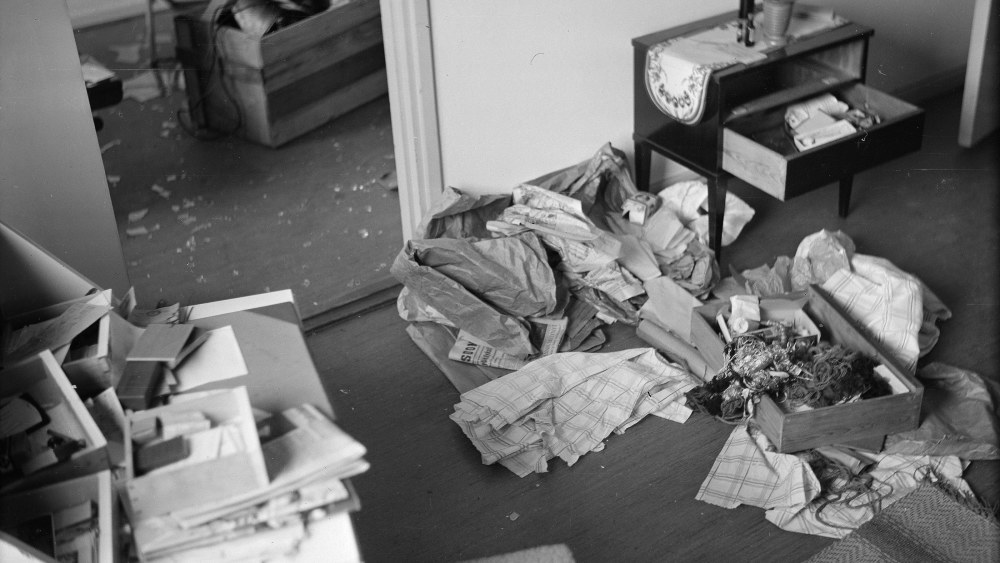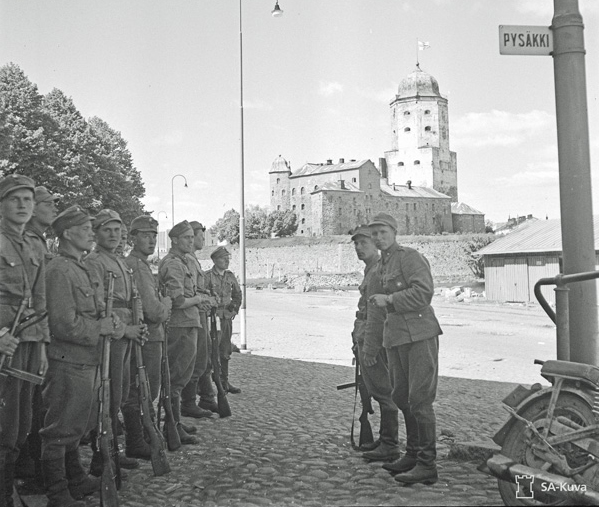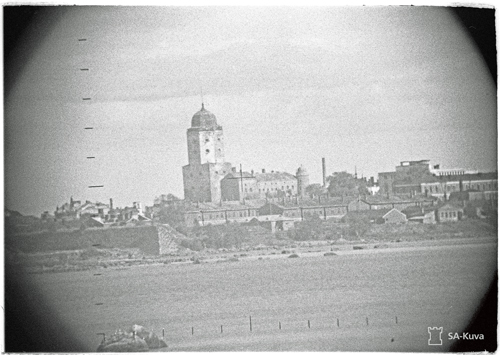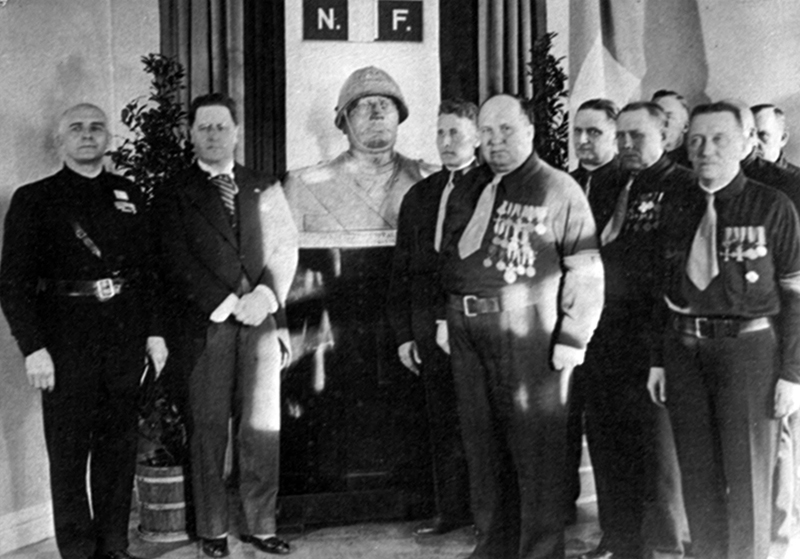*This is a history article, not a question, but telling some facts about the exact event

An apartment in Vyborg on June 19th, 1944 - the next day the city had a new host following the Red Army capturing Vyborg. SA-kuva.
Until this day, it still remains mostly unclear, what or which was/were the reason(s) Finland not fighting for the ownership of Vyborg and not defending the major city for more energetic. The Finnish 2nd largest city was lost nearly without a fight in only few hours.
It's easy to say, mostly known of its combat skill in the wilderness, the Finnish Army couldn't master the urban city fighting. However, in 1941 the Finnish Defense Forces re-captured three Finnish cities and one Soviet city. To understand the 1944 catastrophe, one must be aware of the situation which prevailed on the Karelian Isthmus in the summer of 1944.
The Red Army had advanced almost unstoppably for 1 and a half-week - circa 100 kilometres since launching its offensive against Finland on the Karelian Isthmus. Before the June 20th the Finnish Army had been incapable in putting a proper fight against the Soviets. The Finns were on the run, the army was routing and panicked. The situation in the front line changed rapidly and while information reached the staff and HQ officers, it was often obsolete already.

Facial experssions are already serious. 2nd lieutenant giving a speech for his men at a public transport stop a few days before the loss of the city. The 13th century Finnish-Swedish built Vyborg Castle on the background. SA-kuva.
While understanding the seriousness of the situation, the Finnish Army began sending reinforcements and replenishment forces onto the Karelian Isthmus. The Finnish 20th Infantry Brigade received an order to march by a train from the Olonets Karelia to the Isthmus and join the Finnish counter-attack. However, the situation had worsened heavily while the arrival of the brigade and the new order only included to set-up the defense of Vyborg.
The 20th Brigade arrived Vyborg on 18th and 19th of June. There was a full panic in the city. The city had been evacuated of the civilians, but the evacuation was only half-complete while the civilian belongings were only standing alone on the railway station, the rail-yard, on the rail-cars or in the apartments. The city was filled of hundreds of scattered Finnish soldiers fleeing before the Soviet offensive, it wasn't retreat, it was running and routing through the city, there are rumors about officers shooting soldiers in order to stop the running and soldiers shooting the officers in order to carry on the running. Only worsening the dilemma, the evacuation of the city's alcohol storage had failed. The rumor spread and the fleeing soldiers started robbing and drinking the booze. While at last the security guard started breaking the storage and the barrels, the liquor and booze ran loose and drain on the open city-gutters, the fleeing soldiers with the crazy-look in their eyes started their attempt to save the liquor onto their helmets and field-bottles.
During the night between the 19th and 20th of June the stampede began to spread also among the 20th Brigade. On the very early hours, circa 2:00-4:00 am, at the morning dusk, the Soviets began the transmission on their loudspeakers:...-Good morning, you young men of the 20th Brigade. The Red Army knows you're there, sitting on your foxholes. This time, all you and your blood will be sacrificed in order to protect Viipuri. It is useless, there are too few of you, you don't have the air-force, no anti-tank weapons, no armament at all...when did you have your last meal? If you choose to oppose the Red Army, you'll waste your life...we promise to you...if you now leave the city and lay down your arms, you leave as unharmed and free...anyway, the Red Army will drink afternoon tea at Viipuri market square later on today.
At 7:00-8:00 am the Red Army attacked against the Finnish lines in the city, supported by the Soviet air-force and T-34's and KV-tanks. The 20th Brigade countered the Soviet approaching, but the line was already wavering. Without a proper Finnish counter-measure, the Soviets broke through the Finnish line before the noon. However, there was at least a 300-meters-long, unoccupied and emptied of the Finnish defenders gap in the front line, nearly for three hours. This was the time when the Finns started launching the desperate counter-attack. It's rumored, the leading officers were heavily drugged of with pervitin and while they reached the gap in the front line, they were only alone, with just a few soldier among them.
During the first hours of the afternoon, a general Finnish retreat was a prevailing situation in the city having the Soviets following. At the city-center, still today, there stands Patterinmäki - the Battery Hill. An old fortification line, from the Finnish-Swedish era, there the Finns attempted the second-line-in-defense, but failing badly. 5 000 Finnish soldiers retreated or ran through Viipuri, having 40 000 Soviet soldiers following.

There...it had to be left. Viipuri viewed by a Finnish branch-telescope at August 1944 at Tienhaara. The Soviet Union carried on the grand offensive after capturing Viipuri, but couldn't break the Finnish lines at Tienhaara, Äyräpää-Vuosalmi, neither at Tali-Ihantala.
Mannerheim stated the loss of Vyborg as the 'greatest scandal of all the time in the Finnish military history'. Even he doubted, after the Soviets capturing the city, the Finns had lost their will to fight. However, surprisingly, after Vyborg, the Finns managed to hold the line in all fronts, achieving decisive victories and putting a halt for the Soviet offensive.
Viipuri-Vyborg stands in the same rating with Köningsberg-Kaliningrad today.

An apartment in Vyborg on June 19th, 1944 - the next day the city had a new host following the Red Army capturing Vyborg. SA-kuva.
Until this day, it still remains mostly unclear, what or which was/were the reason(s) Finland not fighting for the ownership of Vyborg and not defending the major city for more energetic. The Finnish 2nd largest city was lost nearly without a fight in only few hours.
It's easy to say, mostly known of its combat skill in the wilderness, the Finnish Army couldn't master the urban city fighting. However, in 1941 the Finnish Defense Forces re-captured three Finnish cities and one Soviet city. To understand the 1944 catastrophe, one must be aware of the situation which prevailed on the Karelian Isthmus in the summer of 1944.
The Red Army had advanced almost unstoppably for 1 and a half-week - circa 100 kilometres since launching its offensive against Finland on the Karelian Isthmus. Before the June 20th the Finnish Army had been incapable in putting a proper fight against the Soviets. The Finns were on the run, the army was routing and panicked. The situation in the front line changed rapidly and while information reached the staff and HQ officers, it was often obsolete already.

Facial experssions are already serious. 2nd lieutenant giving a speech for his men at a public transport stop a few days before the loss of the city. The 13th century Finnish-Swedish built Vyborg Castle on the background. SA-kuva.
While understanding the seriousness of the situation, the Finnish Army began sending reinforcements and replenishment forces onto the Karelian Isthmus. The Finnish 20th Infantry Brigade received an order to march by a train from the Olonets Karelia to the Isthmus and join the Finnish counter-attack. However, the situation had worsened heavily while the arrival of the brigade and the new order only included to set-up the defense of Vyborg.
The 20th Brigade arrived Vyborg on 18th and 19th of June. There was a full panic in the city. The city had been evacuated of the civilians, but the evacuation was only half-complete while the civilian belongings were only standing alone on the railway station, the rail-yard, on the rail-cars or in the apartments. The city was filled of hundreds of scattered Finnish soldiers fleeing before the Soviet offensive, it wasn't retreat, it was running and routing through the city, there are rumors about officers shooting soldiers in order to stop the running and soldiers shooting the officers in order to carry on the running. Only worsening the dilemma, the evacuation of the city's alcohol storage had failed. The rumor spread and the fleeing soldiers started robbing and drinking the booze. While at last the security guard started breaking the storage and the barrels, the liquor and booze ran loose and drain on the open city-gutters, the fleeing soldiers with the crazy-look in their eyes started their attempt to save the liquor onto their helmets and field-bottles.
During the night between the 19th and 20th of June the stampede began to spread also among the 20th Brigade. On the very early hours, circa 2:00-4:00 am, at the morning dusk, the Soviets began the transmission on their loudspeakers:...-Good morning, you young men of the 20th Brigade. The Red Army knows you're there, sitting on your foxholes. This time, all you and your blood will be sacrificed in order to protect Viipuri. It is useless, there are too few of you, you don't have the air-force, no anti-tank weapons, no armament at all...when did you have your last meal? If you choose to oppose the Red Army, you'll waste your life...we promise to you...if you now leave the city and lay down your arms, you leave as unharmed and free...anyway, the Red Army will drink afternoon tea at Viipuri market square later on today.
At 7:00-8:00 am the Red Army attacked against the Finnish lines in the city, supported by the Soviet air-force and T-34's and KV-tanks. The 20th Brigade countered the Soviet approaching, but the line was already wavering. Without a proper Finnish counter-measure, the Soviets broke through the Finnish line before the noon. However, there was at least a 300-meters-long, unoccupied and emptied of the Finnish defenders gap in the front line, nearly for three hours. This was the time when the Finns started launching the desperate counter-attack. It's rumored, the leading officers were heavily drugged of with pervitin and while they reached the gap in the front line, they were only alone, with just a few soldier among them.
During the first hours of the afternoon, a general Finnish retreat was a prevailing situation in the city having the Soviets following. At the city-center, still today, there stands Patterinmäki - the Battery Hill. An old fortification line, from the Finnish-Swedish era, there the Finns attempted the second-line-in-defense, but failing badly. 5 000 Finnish soldiers retreated or ran through Viipuri, having 40 000 Soviet soldiers following.

There...it had to be left. Viipuri viewed by a Finnish branch-telescope at August 1944 at Tienhaara. The Soviet Union carried on the grand offensive after capturing Viipuri, but couldn't break the Finnish lines at Tienhaara, Äyräpää-Vuosalmi, neither at Tali-Ihantala.
Mannerheim stated the loss of Vyborg as the 'greatest scandal of all the time in the Finnish military history'. Even he doubted, after the Soviets capturing the city, the Finns had lost their will to fight. However, surprisingly, after Vyborg, the Finns managed to hold the line in all fronts, achieving decisive victories and putting a halt for the Soviet offensive.
Viipuri-Vyborg stands in the same rating with Köningsberg-Kaliningrad today.
- 1











